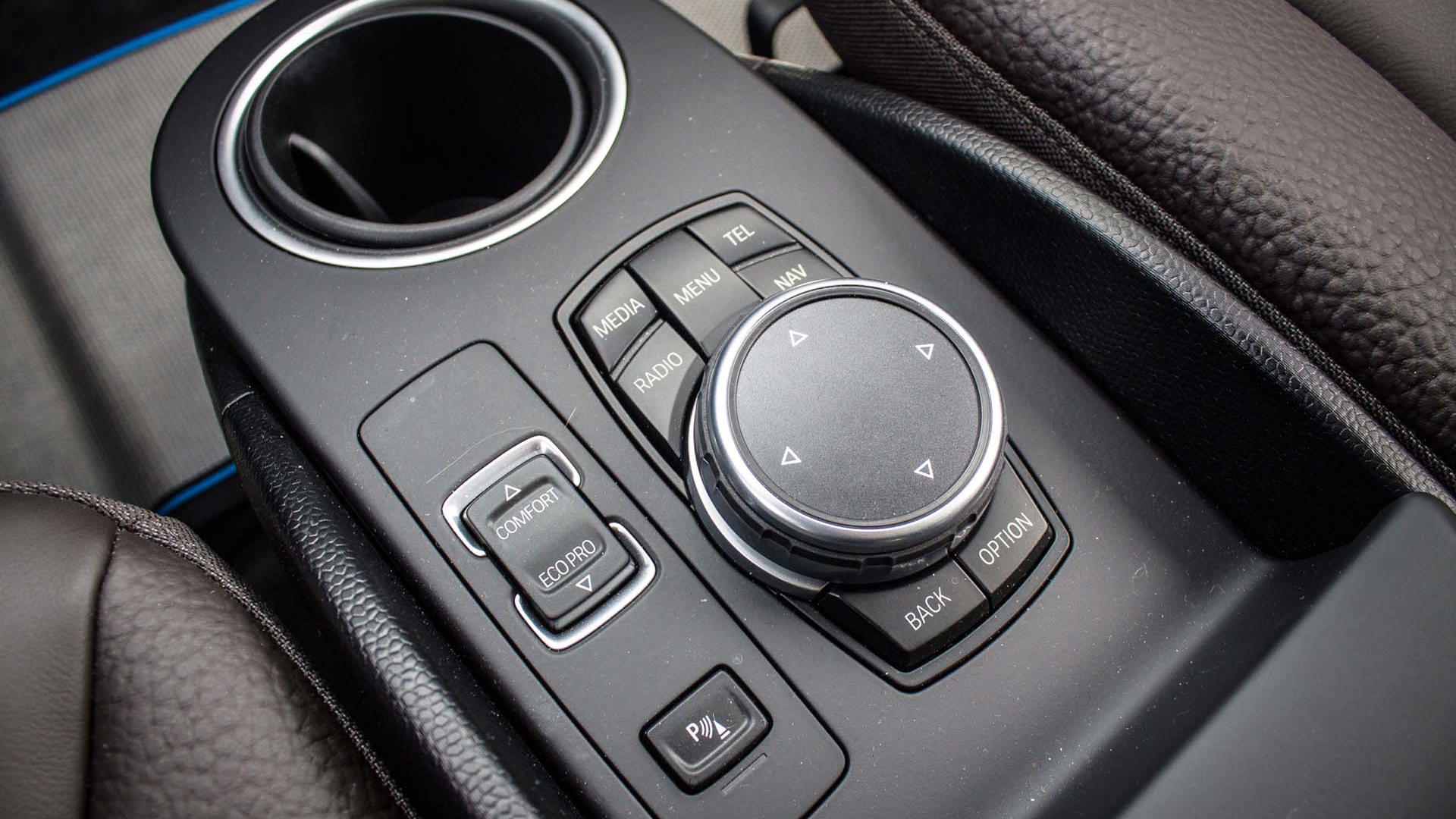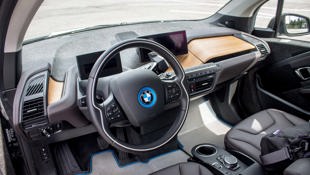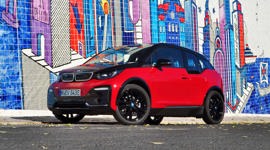 AutoTrader SCORE
AutoTrader SCORE
-
EXTERIOR STYLING8/10
-
INTERIOR8/10
-
PERFORMANCE8/10
-
COMFORT8/10
-
FUEL ECONOMY6/10
Nothing but wind and tire-roar and the cheery raspberry of a 1970s BMW 2002tii. And then the V6 snort of a DeLorean DMC-12. And the cackling French insanity of a Renault 8 Gordini. And the tenor of a Datsun 240Z. The flat-four racket of a Porsche 356. The rumbling V8 of a Pontiac Beaumont.
Manufactured of carbon-fibre and aluminium, the i3 immediately feels different once you step into its interior.
All these, the sounds of the past, as heard from an all-electric front-row seat. They fizz, rasp, and parple up the Sea-to-Sky highway, headed for a lunch stop in Pemberton; we glide along on electrons, squeezing past on a wave of instant-on electric torque. The classics all sound great, and everyone's having a great deal of fun. What's surprising, I suppose, is how much fun the future is.
This is the BMW i3, and many of you have already skipped ahead to the comments section, there to poke fun at its boxy appearance. If the i8 is a sort of bionic swan, then this thing is the ugly duckling before picture. The BMW kidney grilles look like the pushed-in nose of a pug, the greenhouse profile is a strange blob of divots and floating roof, and the tall-skinny wheels look like there's some tractor in this car's DNA.
It's so bizarre. I absolutely love it.
Yes, the i3 is weird, but it shouldn't apologize for it. Aping conventional car design would be a total mistake, and BMW's binning of the rule-book is a win. Just as that classic 2002tii's boxy shape belied an agility that made the big-bore land yachts of the time look silly, this little oddball has a trick or two up its sleeve. It's hardly perfect, but it's very likeable.
Manufactured of carbon-fibre and aluminium, the i3 immediately feels different once you step into its interior. The swell of the wooden dash and the bright, floating screens broke up an otherwise slightly Spartan interior; dour-but-cheerful, that's BMW for you.
The longer you sit in this car, the more surprising it is. Instead of de rigeur do-nothing shiny carbon-fibre-look trim through the cabin, you get actual composite peeking through the door sills and door cards that look made from dryer balls. The steering wheel looks like it's on upside-down. The floor is totally flat.
And yet, it's still a BMW, which means that anyone already familiar with the Bavarian's menu setup and control devices will be immediately at home. Apart from the twist-to-select-drive gearshift to the right of the instrument panel, the i3 offers some conventionality to its control layout. You could trade in your 328i and be setting your radio presets and pairing your phone within minutes.
Another surprise comes when you attempt to use the i3 as a family car. Having decided I was going to tag along on a hodgepodge classic car run, I brought along the kid and her choice of Hot Wheels (one DeLorean DMC-12, one E30 M3). Thanks to the rear-opening half doors, getting the Isetta-sized car-seat wrestled into place was easy. The flat floor meant she could clamber in with ease, and the scalloped sill on the rear window meant her view was as good as mine up front. She also loved how quiet it was, and spent the rest of the week pointing out the roundel on every BMW she saw.
Even though most i3s will be single-occupant commuters, BMW's pillarless design does make the most of the space the four seats allow. With nearly the same compact maneuverability as a Smart ED, the i3 brings useful enough passenger and cargo capacity that a family of four could live with it as an alternative to a combustion-engine-powered runabout. Or a Mazda RX-8, to invoke a suitably weird comparison.
But not so weird. The RX-8 is a 2+2 sportscar, something you buy for its emotional appeal. The i3 is likewise – well not a sporting machine, but not a choice that needs to be made purely on cold analysis. Yes, electric power in BC is cleaner than fuel, and yes there are certainly monetary arguments to be made that incorporate reduced maintenance costs. However, it's perfectly acceptable to consider buying the relatively expensive i3 for the simplest reason in the book: because you want it.
A the top end of the EV food chain, you have the Model S, preferably with the dual-drive and the biggest battery. This is the new Porsche 911 of status symbols, a way to let the world know you're both moneyed and an early adopter. The Model S looks great, goes fast, and is costly.
And then down in entry-level EV land, we have the Focus EV and the Nissan Leaf, and other appliance-like machines. Practical. Conventional. Sensible.
The i3 occupies a sort of middle ground, both in performance and intent. It's far quicker than the appliances, easier to park than the Model S, wildly modern but still useful. There's brand cachet there from the BMW badge on the nose, and a bit of enviro-cred to go with it.
Numbers-wise, there's not much to make the i3 immediately leap out at you. As befits a proper BMW, it's rear-wheel-drive with 125-kW (175 hp) of power and an instant-on surge of 184 lb-ft of torque. With a curb-weight significantly less than a Leaf, 0-100km/h comes in just under eight seconds for even the heavier range-extended versions. But it's the 0-60km/h silent hole-shot that really impresses. Scooting around town, the i3 can jump up and walk away with ample reserves of power.
Drive in a fashion that's more about efficient than dynamics, and the i3 looks a little less impressive. The 18.8 kWh battery gives a stated range of approximately 130-160kms in best-case scenario, but you'll likely get between 110-120 depending on driving style. Just like gasoline-powered cars, it takes gentle inputs to get the best mileage out of an EV.
It also takes a very short learning curve to figure out how to hardly ever use the brakes. Instead, let the electric motor handle the deceleration – come off the throttle and it slows you relatively quickly. You have to look ahead a bit, but you should be doing that anyway.
Short wheelbase, ample torque, skinny tires, and a high seating profile might have you thinking the i3 is a bit of a wobbler. But not at all – with the weight so low-mounted, it took to the sweeping curves of the Sea-to-Sky with ease. If anything, effort had to be made to keep the speedometer reined in. The cops will still write you a good old-fashioned paper ticket if they catch you burning electrons past the speed limit.
As a highway car, there is a slight nervousness to the i3's steering, but take that as a compliment BMW. Just as the Fiesta ST has a bit of a darty nature, so does the i3. The later isn't quite the same type of fun as the fast Ford, but it's lively enough that the charm isn't all coming from the classics we pass.
However, zipping up the hilly highway has nibbled away considerably at the i3's battery levels, so it's time for a jolt of electricity. Having downloaded several apps to find and unlock the various free charging points starting to cross the lower mainland, I pulled up in front of Squamish's main charging station, ready to go. It was even located by a park; we would play in sunshine while the car charged.
Except, owing to lack of planning on the part of yours truly, the plug was CHAdeMO and would not fit the i3's socket. Oops.
When the classics we were running alongside of were new, getting around Canada required some planning. You had to know where your service stations were, you had to keep an eye on your water temperatures, and know how to deal with the constant flat tires of old tire technology. You needed a road map.
These days, you jump in and the car does practically everything for you. However, if you've got an electric car, the infrastructure isn't quite at the level it needs to be in order to traipse around the province without at first looking things up.
However, here too BMW has a stopgap solution. The i3 may be equipped with an optional 647cc two-cylinder gasoline range-extender. Had it not been installed, our trip might have ended a few kilometres short of home, but it kicked on with a noisy thrum a few exits away from the final off-ramp. After all that quiet electric cruising, the noise was a little off-putting.
And that, perhaps, is why none of the i3 owners I interviewed had the range extended version. All had the pure electric version, and none had trouble with the range.
There was no real common denominator either. One i3 belonged to a retired couple up the valley, who used their e-Bimmer as a way to get out to the dykes; their only wish was that the windows would roll down so their dogs could stick their heads out. Another belonged to an early-adopter electrical engineer who liked the technology but thought BMW could do a better job training their employees on it. Another lived in a strata housing complex with a large common area that featured several charging bays for electric cars. Some only charged their i3s at home; some used charge points at work or regular parking and shopping areas.
All had owned their i3s for at least two years, and all said they would buy a BMW i-product again (the engineer said he'd look at an Audi EV too). Despite differing ages and housing situations, all seemed to have adapted to EV ownership without difficulty.
And that's why I too would recommend going without the i3's range extender. It's a crutch, and you don't need it, not if you're going to make the leap to EV ownership. Learn how to plan ahead a little bit, and figure out where your local plugs are. The infrastructure will catch up soon.
As for the i3 itself, I'll put it this way. The heterogeneous mob of vintage metal I chased up to Squamish represented a deep and abiding passion for the automobile. It wasn't just about the speed, though there were speedy cars there. It wasn't just the regal splendour of the single Rolls-Royce, nor the oddity of the Bristol. It was a love of character on wheels.
The i3 has character for days. Some will think it ugly. Some will think it too expensive. Some will think it too quirky to be rational. But in an age where the automobile is still an individual choice, the i3 remains an interesting one. Everybody I talked to who owned one absolutely loved it. That's not something you can say about many cars.
| Warranty: 4 years/80,000 km; 4 years/80,000 km powertrain; 12 years/unlimited distance corrosion perforation; 4 years/unlimited distance roadside assistance; 8 years/160,000 km hybrid components Competitors: |
| Model Tested | 2016 BMW i3 w/ REx |
|---|---|
| Base Price | $45,300 |
| A/C Tax | $100 |
| Destination Fee | $2,095 |
| Price as Tested | $56,845 |
|
Optional Equipment
$9,350 [Range extender - $4,000; i-Suite interior upgrade incl leather, navigation, park assist - $4,600; DC fast-charger - $750]
|
|




































